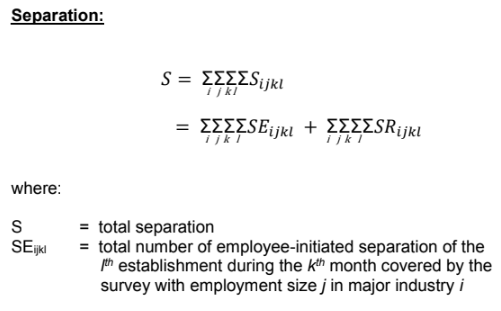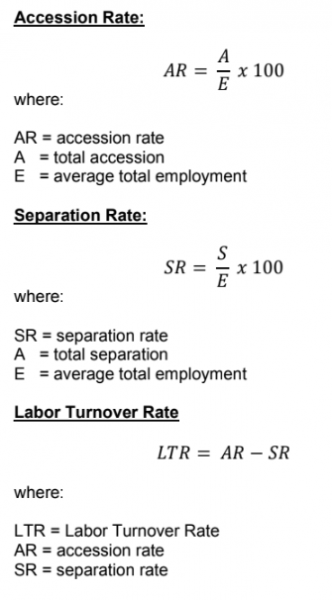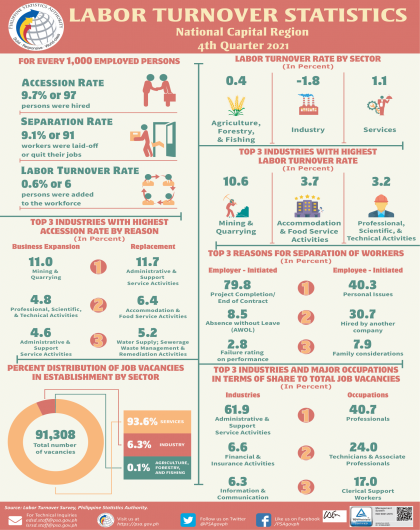Labor Turnover Statistics (National Capital Region, 3rd and 4th Quarters of 2021)
Table of Contents
I. Introduction
II. Data Collection
III. Methodology
IV. Concepts and Definitions of Terms
V. Dissemination of Results and Revisions
VI. Citation
VII. Contact Information
I. Introduction
I.1. Background of the Survey
The Labor Turnover Survey (LTS), one of the regular surveys of the Philippine Statistics Authority, is an offshoot of the Employment, Hours and Earnings Survey (EHES), which was conducted from 1987 to 2002 by the former Bureau of Labor and Employment Statistics (BLES). To come up with timely information on labor market trends in the formal sector of the economy, the items of inquiry have been limited to employment, labor turnover, and existing job vacancies.
I.2. Objectives
The LTS aims to provide quarterly trend statistics on labor turnover and existing job vacancies as indicators of labor market activity and general business situation of the country. This provides the government and the private sector a complete picture of labor demand and job turnover as inputs to decision making and policy formulation.
I.3. Historical Information on the Survey
Prior to 1989, statistics on labor turnover and layoffs were derived from two mandatory reports submitted by employers to the Department of Labor and Employment (DOLE). These reports were the Monthly Employment Report and the Employer’s Termination Report which were submitted in compliance with the implementing rules and regulations of the Labor Code of the Philippines. However, due to low compliance rates, coverage was limited, and the Department was unable to come up with an accurate picture of the dynamics of the labor market.
In 1988, a special study funded by the former National Statistical Coordination Board (NSCB) entitled “Improvement of Client-Based Statistics on Labor and Employment,” was undertaken. Among others, the study recommended the conduct of a national survey of establishments to inquire on labor turnover, vacancies, and layoffs to adequately monitor the labor market performance of the
business sector. This recommendation paved way for the conduct of the Employment, Hours and Earnings Survey (EHES).
From 1989 to 1997, the EHES was conducted as a rider to the then Quarterly Survey of Establishments (QSE) of the former National Statistics Office (NSO). The survey was designed to collect quarterly data on labor turnover, hours of work, layoffs, and job vacancies.
The EHES was revised in 1998 and this entailed the redesigning of the questionnaire and modification of the sampling design in conformance with the 1994 Philippine Standard Industrial Classification. Moreover, the field data collection was assumed by the former Bureau of Labor and Employment Statistics (BLES) in coordination with the DOLE Regional Offices. The revised EHES was conducted from 1998 to 2000 but temporarily discontinued in 2001 due to severe budget constraints. It was resumed in the first semester of 2002, but the coverage was limited only to the National Capital Region and was again discontinued for lack of budget.
In the 2nd semester of 2002, the DOLE Secretary instructed the former BLES to collect quarterly data on labor turnover to complement the data on establishment closures and layoffs. This became the forerunner of the current LTS and was in place from 2002 to 2007. The new survey was designed with “enterprise” as the sampling unit instead of the “establishment” in the EHES. To be manageable and to come up with the results the shortest time possible, the survey was limited in Metro Manila where the bulk of the country’s business enterprises were located. The sample size was fixed at 500 enterprises that were selected through stratified random sampling. Two strata were formed with the first 200 top firms (based on revenue) comprising the first stratum, all of them included as samples. The rest of the enterprises formed the second stratum from which the 300 samples were drawn randomly. The survey results were released based on sample data only.
The survey was redesigned in 2008 with sample enterprises selected from the Top 1,000 Corporations in the country which were sourced from the Credit Information Bureau, Inc. (CIBI). Further improvements were made with the introduction of Kish’s allocation formula to reflect better industry representation. Also, released survey results were based on weighted data and the sample size was no longer fixed but was computed using the said formula.
Starting 4th quarter of 2013, the LTS was conducted by the Philippine Statistics Authority (PSA) due to the implementation of the Republic Act 10625 starting September 12, 2013, otherwise known as the Philippine Statistical Act of 2013.
From 2015 to 2017, the LTS covered a subsample of enterprises with 20 or more workers that are in the National Capital Region (NCR) only using the updated List of Establishments available at the Philippine Statistics Authority (PSA) as sampling frame. As a matter of procedure, the survey gathered consolidated information about the establishment and its branches, if any.
In 2018, the LTS was expanded from its NCR to nationwide coverage to get a more complete picture of the labor market situation in the whole country. Also started from this period, data encoding and machine processing are decentralized at the Regional Statistical Services Offices (RSSOs) except for NCR where the distribution and collection of questionnaires, field editing, data encoding and machine processing were all done at the Central Office until 4th quarter 2018 survey round.
However, due to limited budget, the conduct of nationwide LTS for 2019 was deferred. At the very least, the survey was conducted in a semi-annual frequency covering NCR only and was handled by
the RSSO and PSOs. Data encoding and machine processing was likewise devolved to the NCR provincial offices.
The 2020 LTS rounds were likewise conducted semi-annually covering two (2) quarters information with samples further reduced due to budgetary constraints. Moreover, changes were effected to introduce/cope with the “new normal” brought about by the COVID-19 pandemic. Specifically, ways of engagement were affected or minimized in the conduct of trainings and interviews during questionnaire distribution and collection.
The same strategies are employed for LTS 2021. Field operations are done semi-annually to generate data for two quarters for each survey period. Further, health protocols are still observed, especially during distribution and collection of questionnaires.
I.4.Scope and Coverage
The LTS 2021 covers establishments with 20 or more workers located in NCR as listed by the Philippine Statistics Authority. The survey covers 18 major industries classified according to the amended 2009 Philippine Standard Industrial Classification (PSIC).
II. Data Collection
II.1. Data Collection Procedure
This survey employed a face-to-face interview using a structured questionnaire. In some instances, respondents are contacted through phone and or email to ascertain their location, establish initial contact, and/or to verify submitted figures. The distribution and collection of questionnaires to and from the sample establishments are done by hired Statistical Researchers (SRs).
Under the “new normal” condition, various schemes that will limit face-to-face engagement of the SRs and the respondents are employed during the distribution, follow-up, and collection/transmittal of questionnaires. These strategies include mail or email, phone calls/facsimile.
II.2. The Instrument
The instrument used is a four-page questionnaire that captures the necessary data to obtain the objectives of the survey. It is composed of the cover page, general information, items of inquiry, certification, and information on the survey personnel. The results of the latest LTS conducted as a means of disseminating the information gathered from the survey are provided in a loose sheet and may be retained by the respondent to make them appreciate and may encourage them to participate in PSA statistical activities.
II.3. Data Items
This survey collects data on the establishment’s total employment, accession and separation, reasons for separation, total accession and separation of agency-hired workers, and the existing job vacancies at the end of the quarter.
III. Methodology
III.1. Sampling Frame
The establishment sampling frame for the 2021 Labor Turnover Survey was extracted from the preliminary 2020 List of Establishments (LE) as of 31 December 2020.
This list was a product of the 2020 Updating of List of Establishments (ULE). The updating involved complete enumeration of establishments in the barangays where “no matched” establishments (establishments listed in other sources but not in the LE) from prioritized secondary sources are located, barangays with new malls, barangays having establishments with total employment of 100 and over, and barangays with the highest number of establishments for some provinces. Also covered using mail inquiry, were other “no matched” establishments including those located in distant barangays.
Other sources of updates are the feedbacks from different establishment-based surveys such as Annual Survey of Philippine Business and Industry (ASPBI) and Labor Turnover Survey (LTS).
A total of 15,094 establishments in NCR with employment size of at least 20 workers extracted from the 2020 List of Establishments in the country comprised the LTS 2021 sampling frame.
III.2. Sample Selection Procedure
The 15,094 establishments in NCR included in the frame were stratified based on the eighteen (18) sections as domains.
The initial sample size per stratum was obtained by taking into account the computed highest Coefficient of Variation (CVh) between the estimates on Accession and Separation rates from the result of the 4th Quarter 2020 LTS and a target Coefficient of Variation. For manageability and budget considerations, target CV of 9% was used.
The formula used is as follows:

The distribution of computed samples over domains was done using Kish’s allocation procedure. The formula is defined as:

The result further adjusted the initially computed sample size in each domain for availability of population units per stratum to arrive at the final sample size of 2,842 establishments in NCR.
The sample establishments for each domain were drawn through systematic sampling. This procedure was used so that the representation of establishments with respect to the Total Employment (TE) values are spread out, thus avoiding all sample establishments with low TE values or high TE values.
No replacement of sample establishments is made as the final sample has already been adjusted.
III.3. Estimation Procedure
Estimates are obtained by simple expansion, i.e., by multiplying the sample values at the industry level by the corresponding blowing-up factor (BUF) which is the ratio of the estimated population of establishments to the number of responding establishments. These estimates are then aggregated to the desired totals. This weighing procedure takes non-response into account.




III.4. Other Related Topics
III.4.1. Adjustments
Non-response: Non-response is taken into account in the weighing procedure.
Other bias: No adjustments are made.
Use of benchmark data: No benchmark data is used.
Use of other surveys: No other survey data are used.
III.4.2. Indicators of the Reliability of the Estimates
Coverage of the sampling frame: Partially updated.
Sampling error/Sampling variance: Standard errors (SE) and Coefficient of variations (CV) are computed.
Response rate: For the 3rd and 4th quarter 2021 LTS, the response rates in terms of eligible units are 85.4% and 83.6%, respectively.
Non-sampling errors: These may occur due to inaccuracies in reporting by establishments and enumerators, mistakes in coding, editing and data entry. However, efforts are made to reduce non-sampling errors by careful design of the questionnaire, intensive training of survey personnel, linkages with key informants (employers’ and workers’ groups, government agencies and the academe) and through adoption and documentation of efficient operating procedures.
IV. Concepts and Definitions of Terms
Total employment - refers to the number of persons who worked or received pay from the establishment during the reference period. This includes the following:
Working Owners – owners who are actively engaged in the management of the establishment but do not receive regular pay.
Unpaid Workers – refer to persons working without pay and work for at least 1/3 of the working time normal to the establishment; and
Paid Employees - include full-time/part-time workers; employees on paid leaves (e.g., sick/vacation/maternity/holiday/study leave); and employees working away from the establishment but paid by and under the control of the firm.
- It excludes workers that are hired through agencies/contractors, workers on indefinite leave, workers paid purely on commission without employer control.
Labor Turnover – refers to the changes in the employment of an establishment resulting from accessions and separations.
Accessions (New Hires) – refer to permanent or temporary additions to employment in the establishment due to 1) expansion of business activity and 2) replacement of separated workers and
employment resulting from changes in methods/technology of production or service.
Separations - refer to terminations of employment due to (a) layoffs or terminations initiated by the employers due to economic reasons (e.g., lack of market, financial losses, reorganization, end of contract) and non-economic reasons (e.g., gross negligence, AWOL, failure rating on performance, health reasons) and (b) quits or termination initiated by the employees (e.g., resignations due to being hired by another company, to work abroad).
Agency-Hired Workers – workers employed by the contractors to perform or complete a job, work, or service pursuant to a service agreement within or outside the premises of the establishment. They are excluded from the total employment of the establishment.
Existing Job Vacancies – defined as a paid post that is newly created, unoccupied, or unfilled job openings at the end of the quarter which are immediately available for employment and for
which active recruitment steps are being undertaken.
V. Dissemination of Results and Revisions
V.1. Schedule of Release
The LTS 2021 is implemented in the NCR only with semi-annual frequency of conduct. Below is the timetable of field operations:
| Reference Period | Field Operation | Target Release of the Results |
| 1st Qtr. and 2nd Qtr. 2021 | August to November 2021 | December 2021 |
| 3rd Qtr. and 4th Qtr. 2021 | February to May 2022 | June 2022 |
V.2. Forms of Dissemination
Preliminary results of the survey will be disseminated through a Press Release simultaneous with the statistical tables five months after the start of field operations. Final results will be made available
and posted in the PSA website through a monograph (LABSTAT Updates) and Infographics one month later.
VI. Citation
Philippine Statistics Authority, (June 2022). Technical Notes on 2021 Labor Turnover Survey.
Link: https://psa.gov.ph/statistics/technical-notes.
VII. Contact Information
Alegria A. Mota
Chief Statistical Specialist, EDSD
Tel No.: 8281-7998
Email address: edsd.staff@gmail.com / edsd.staff@psa.gov.ph
For data requests, you may contact:
Knowledge Management and Communications Division
Tel No.: (632) 8462-6600 loc. 839
Email Address: info@psa.gov.ph

